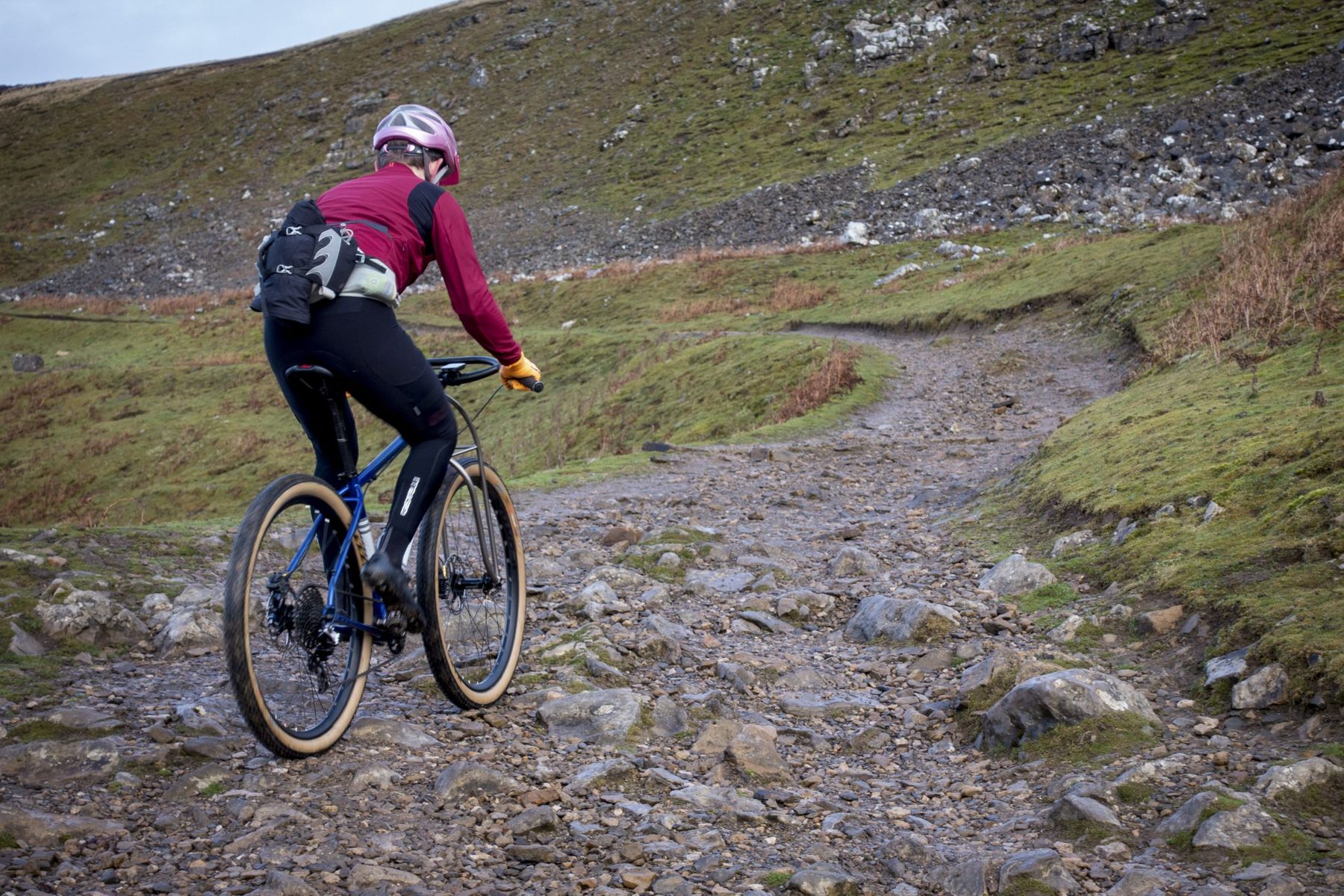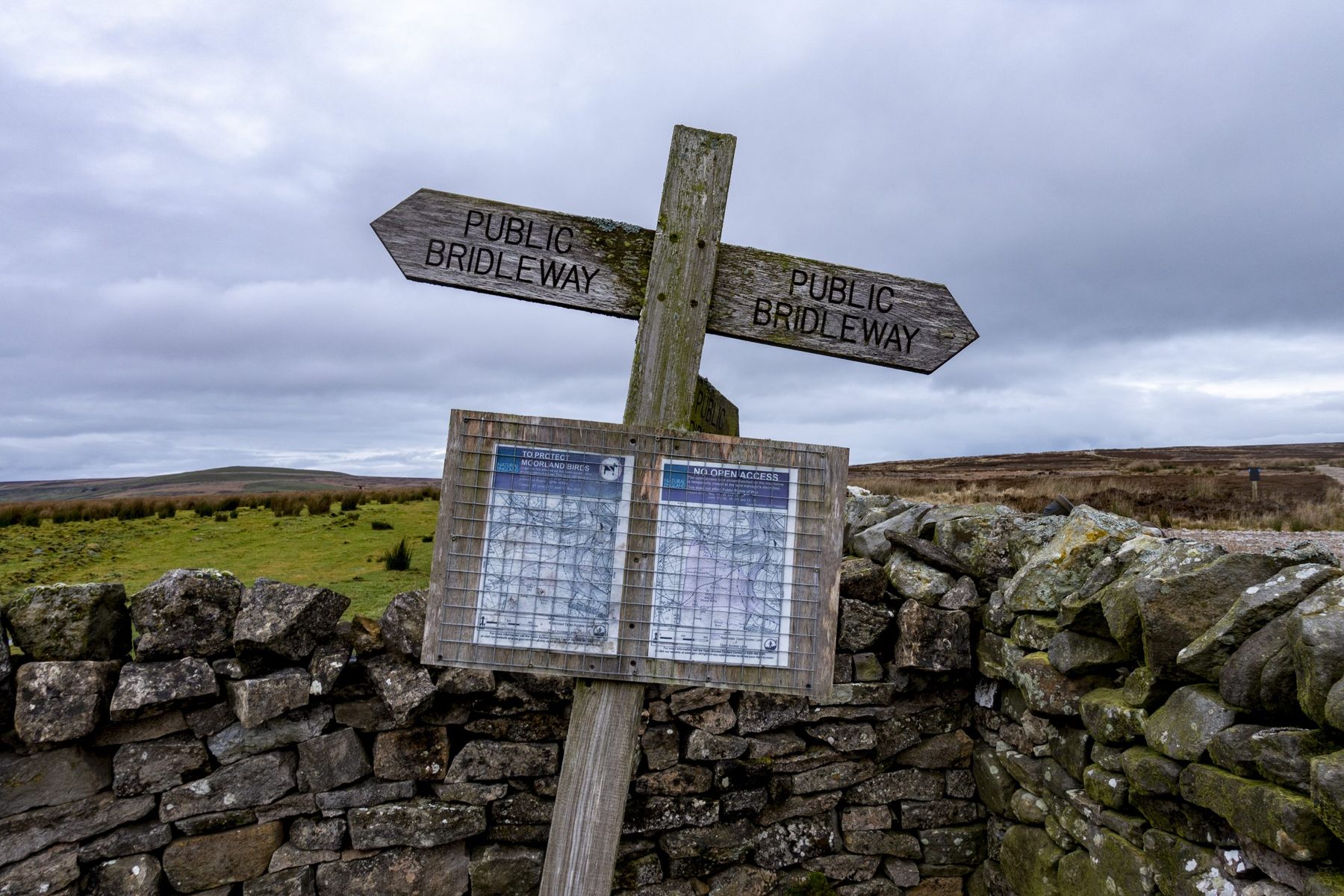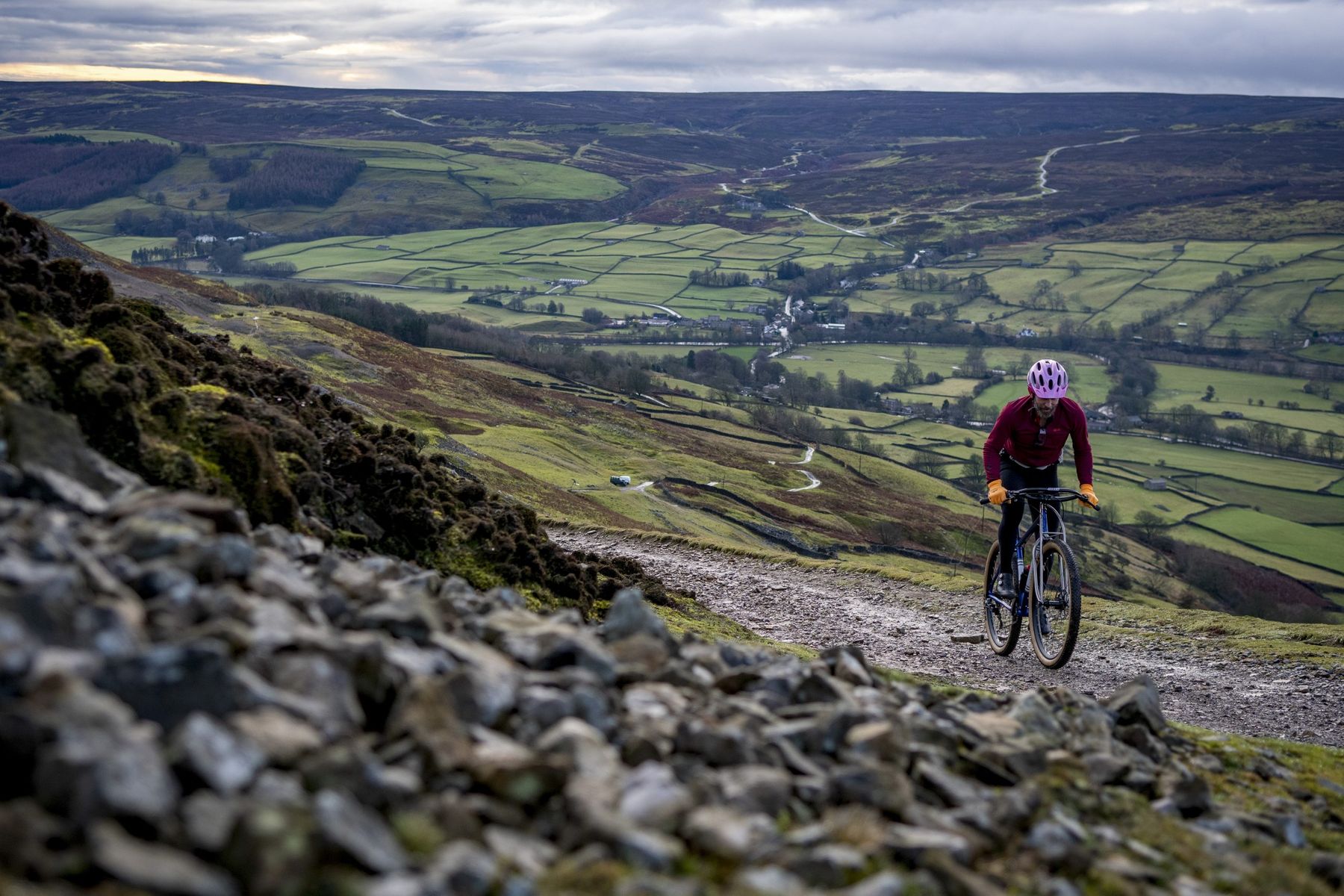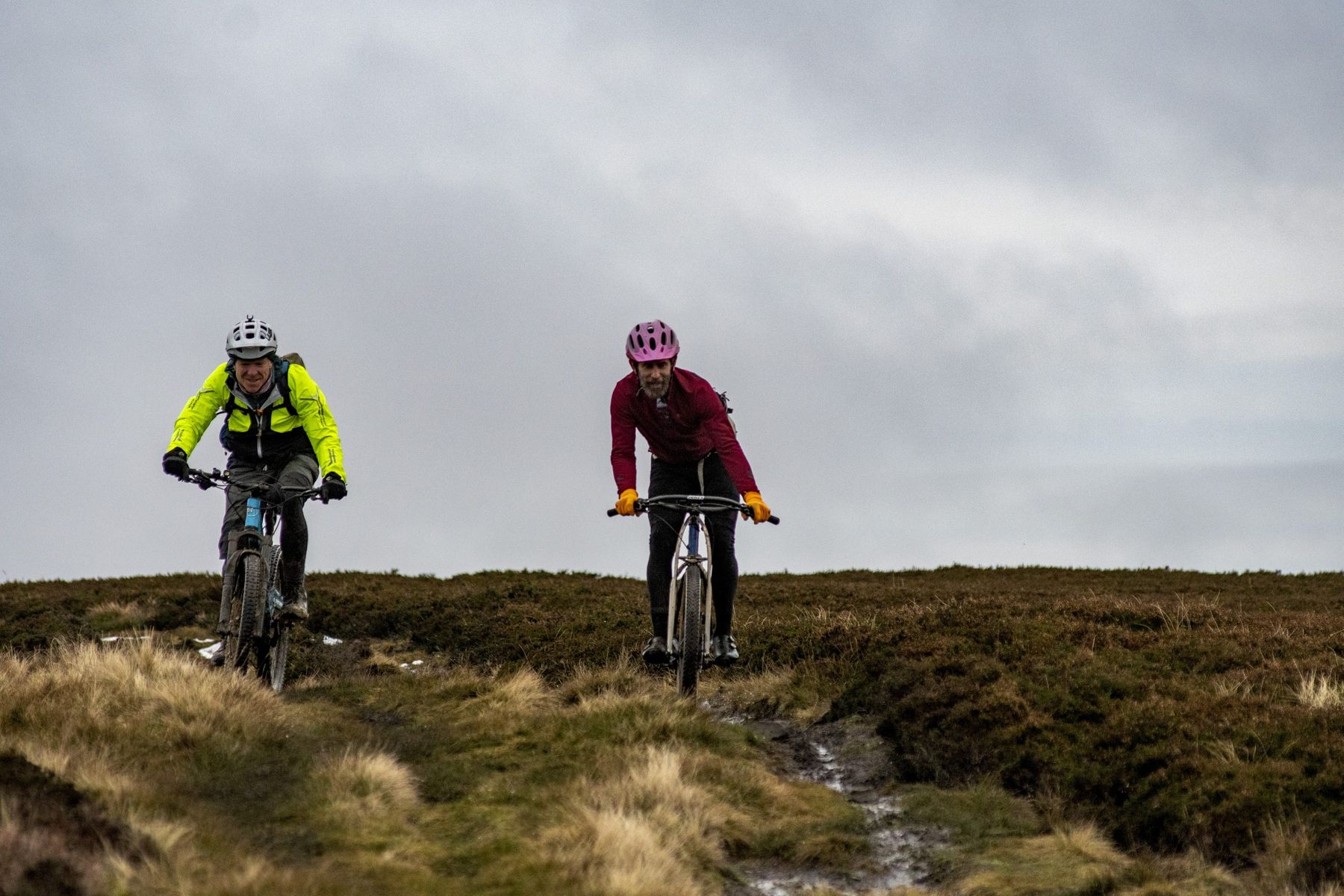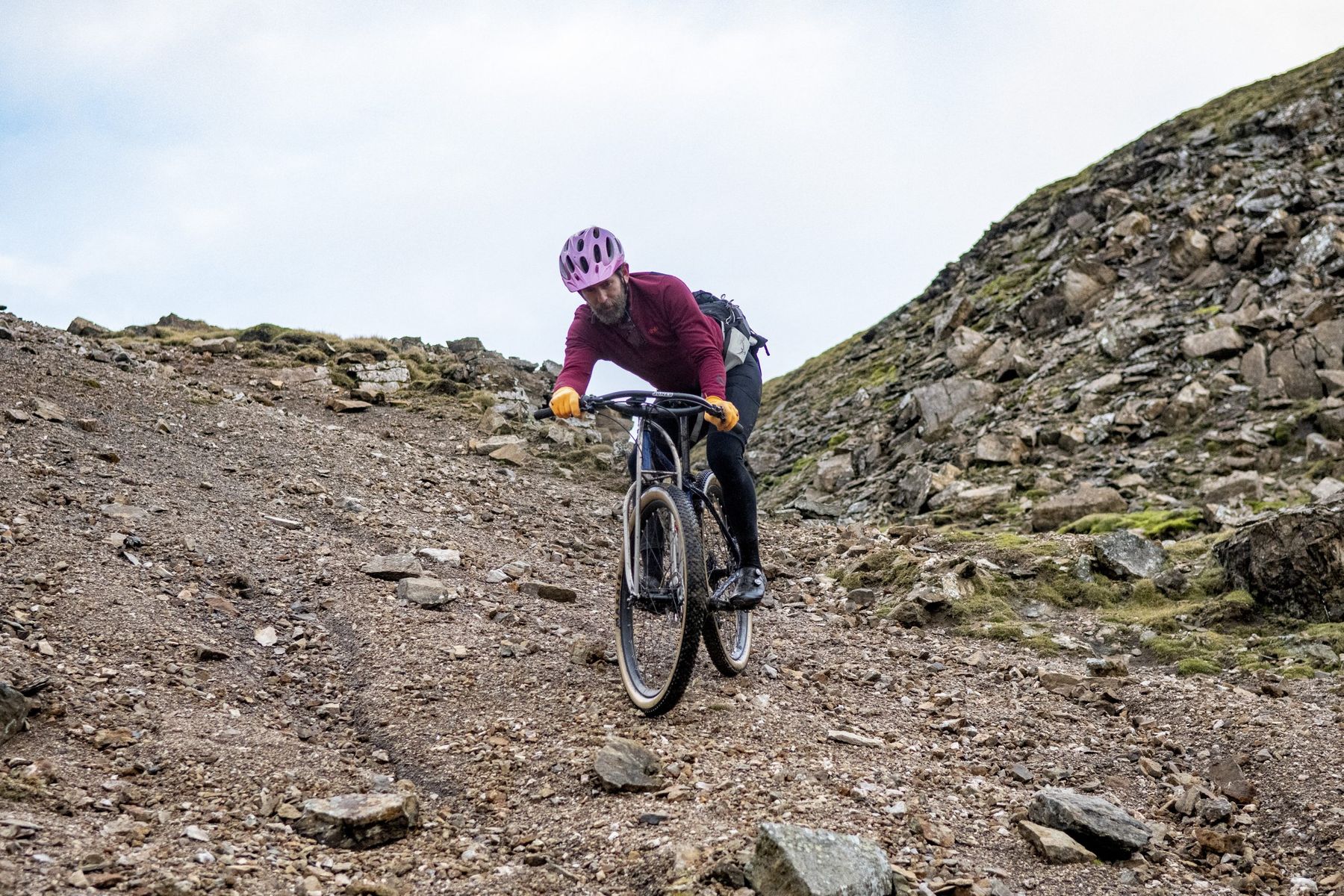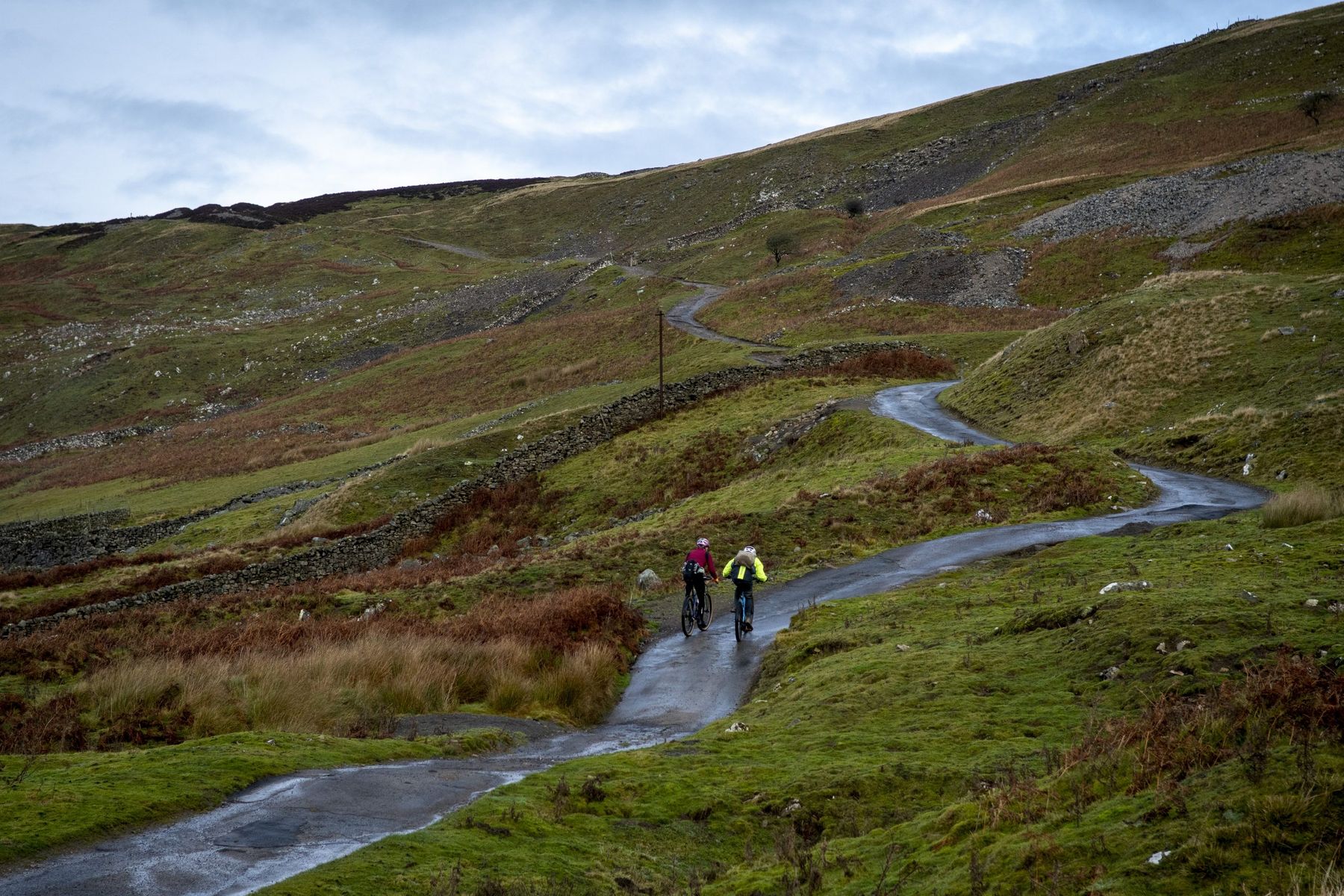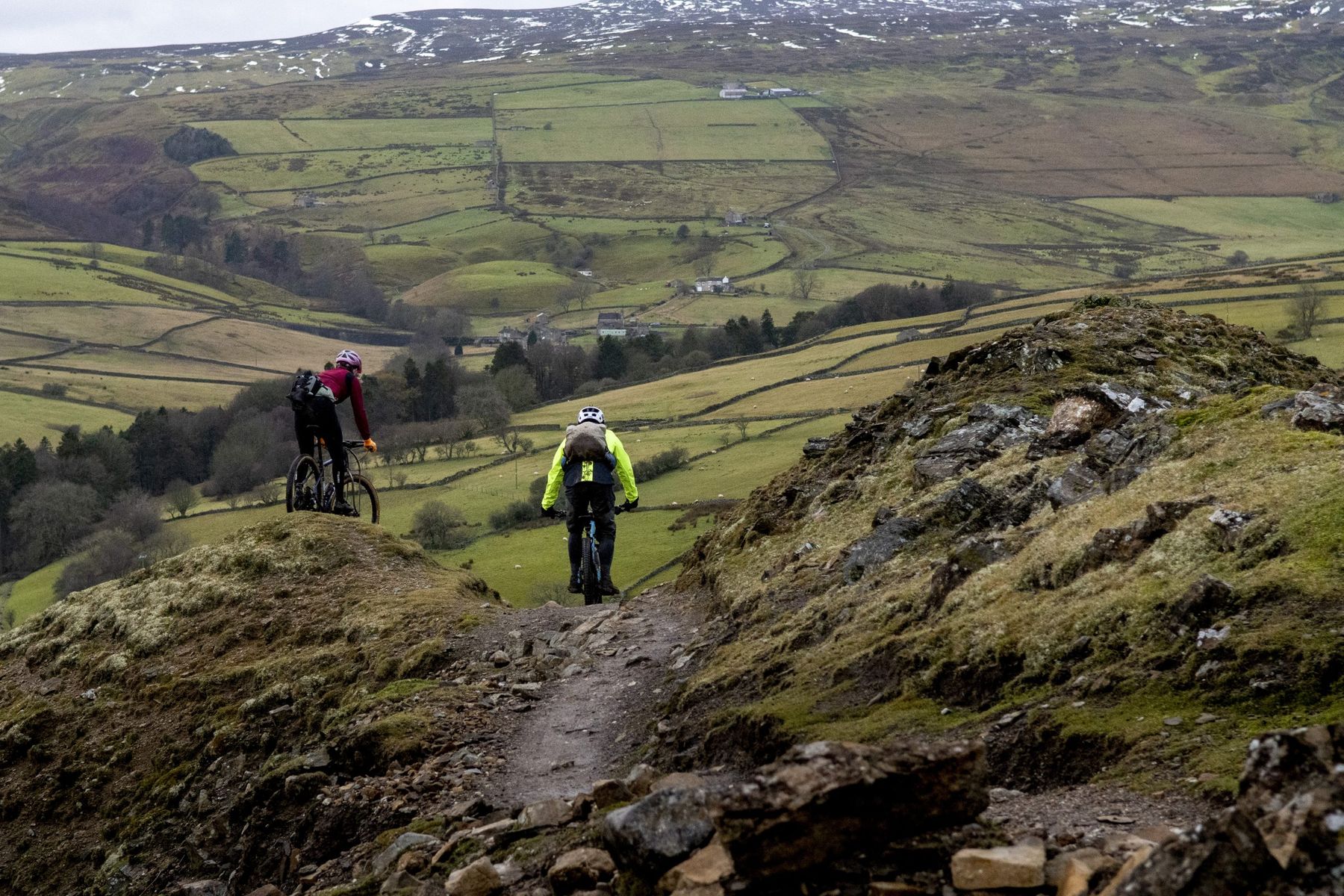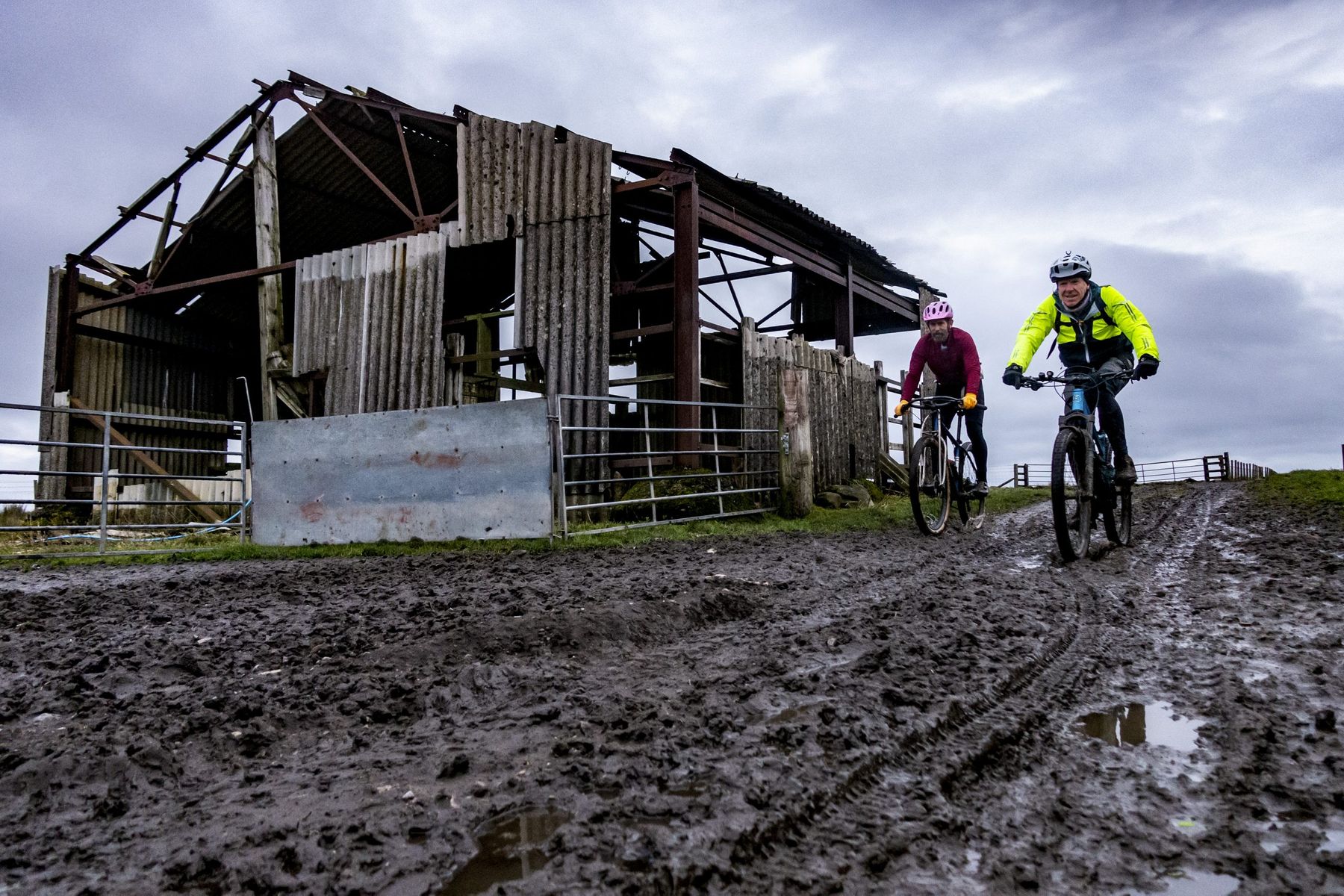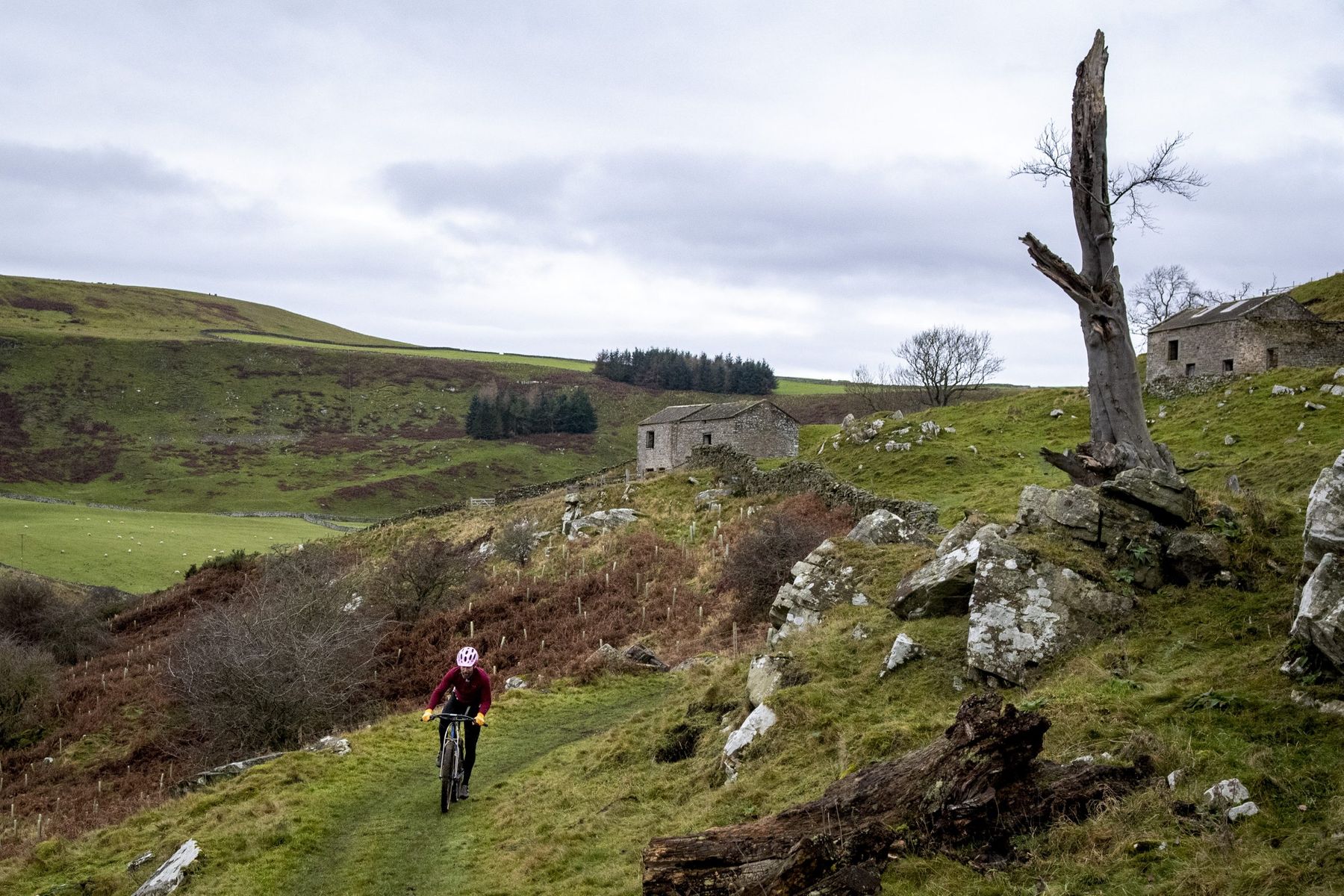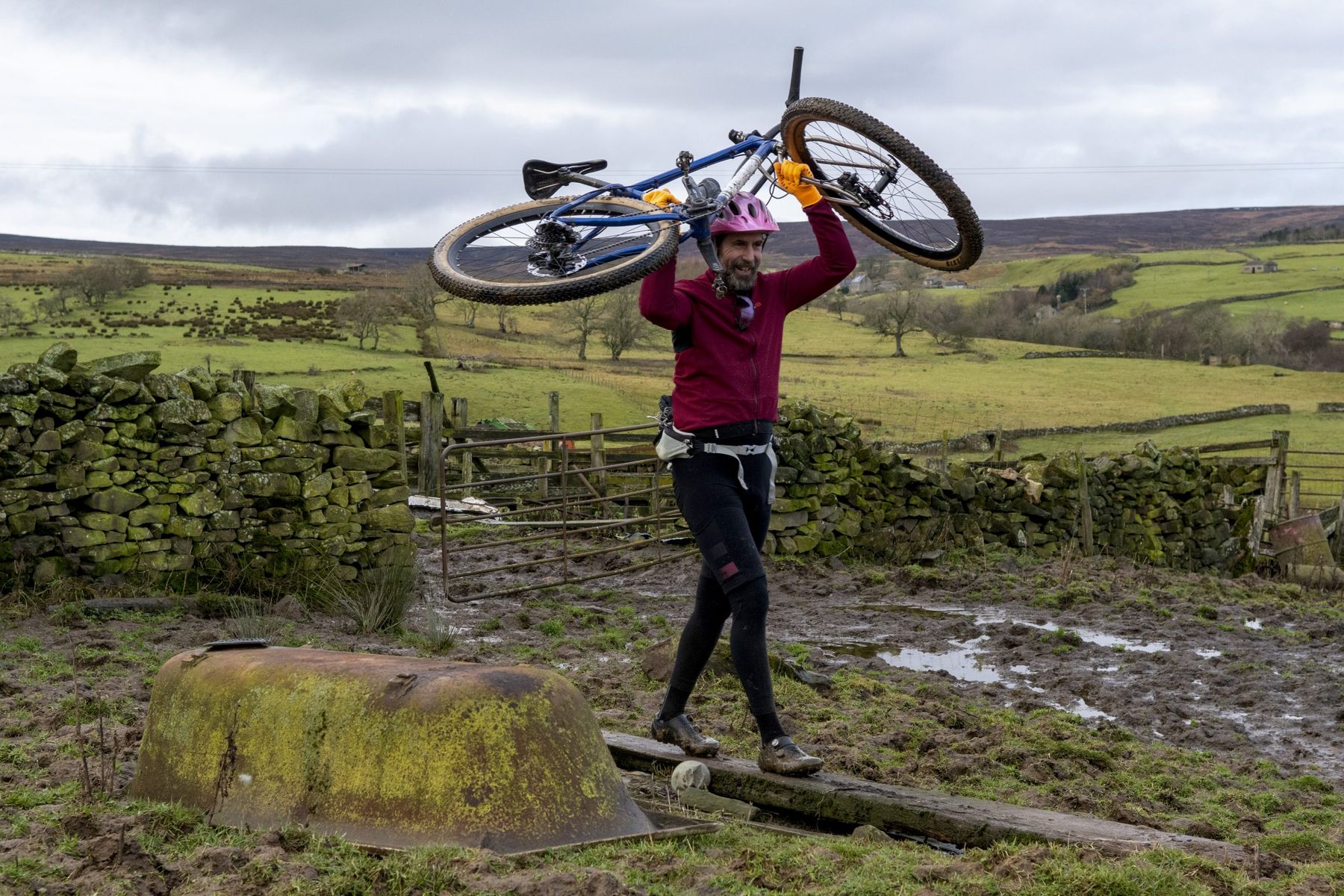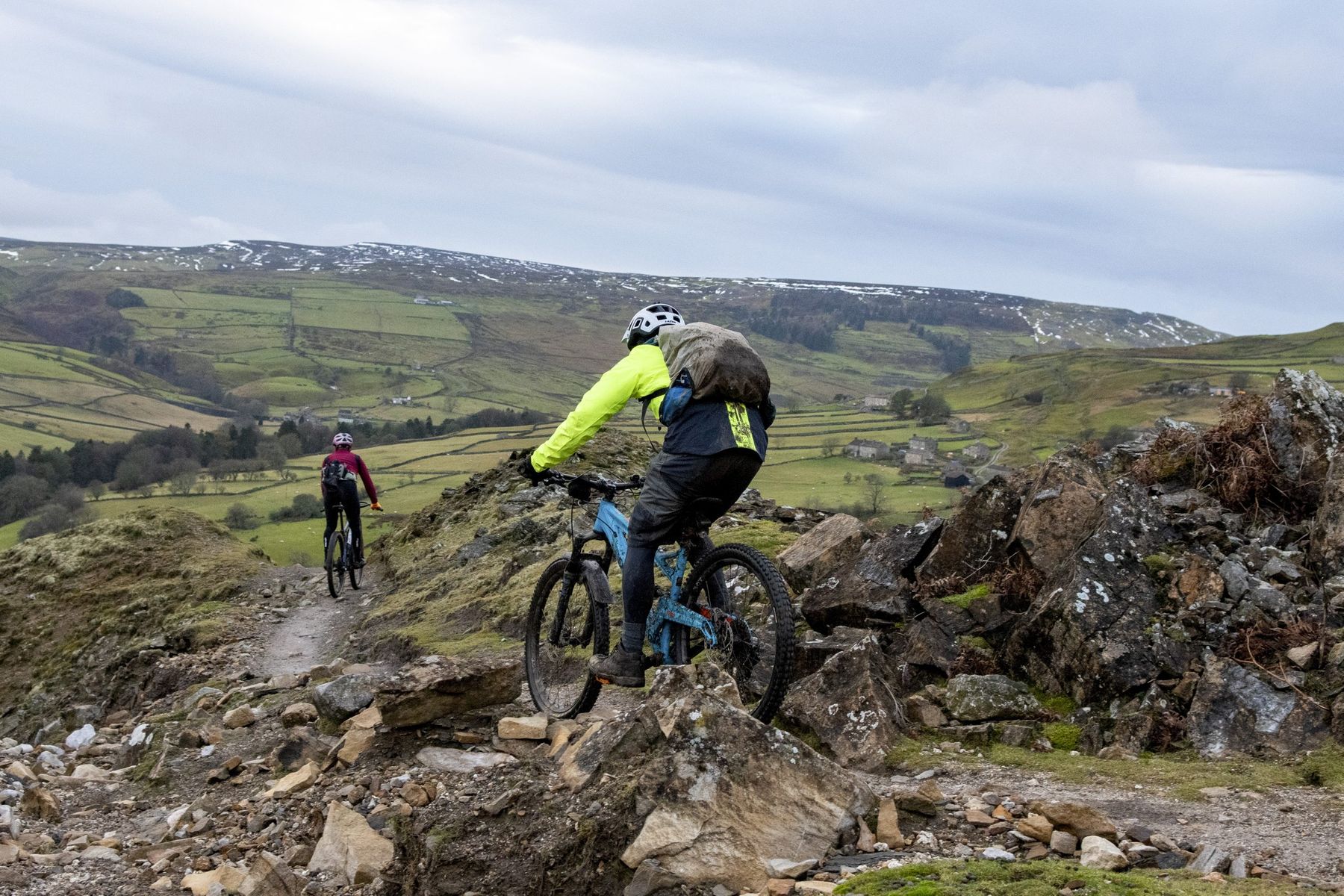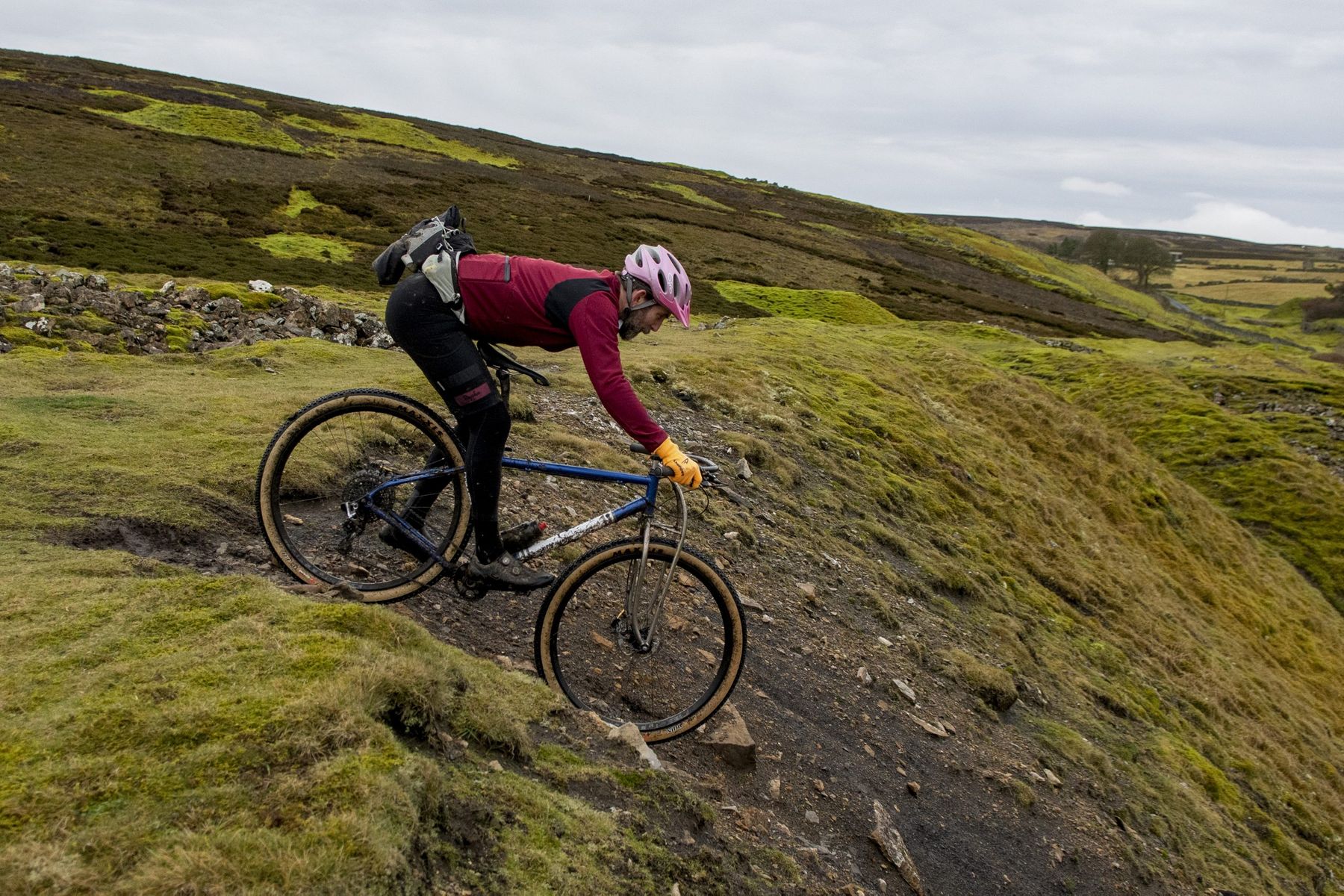
Barney explains why the trails north of Reeth are truly classic – especially if your eyesight is up to the task.
Words & Photography Barney Marsh
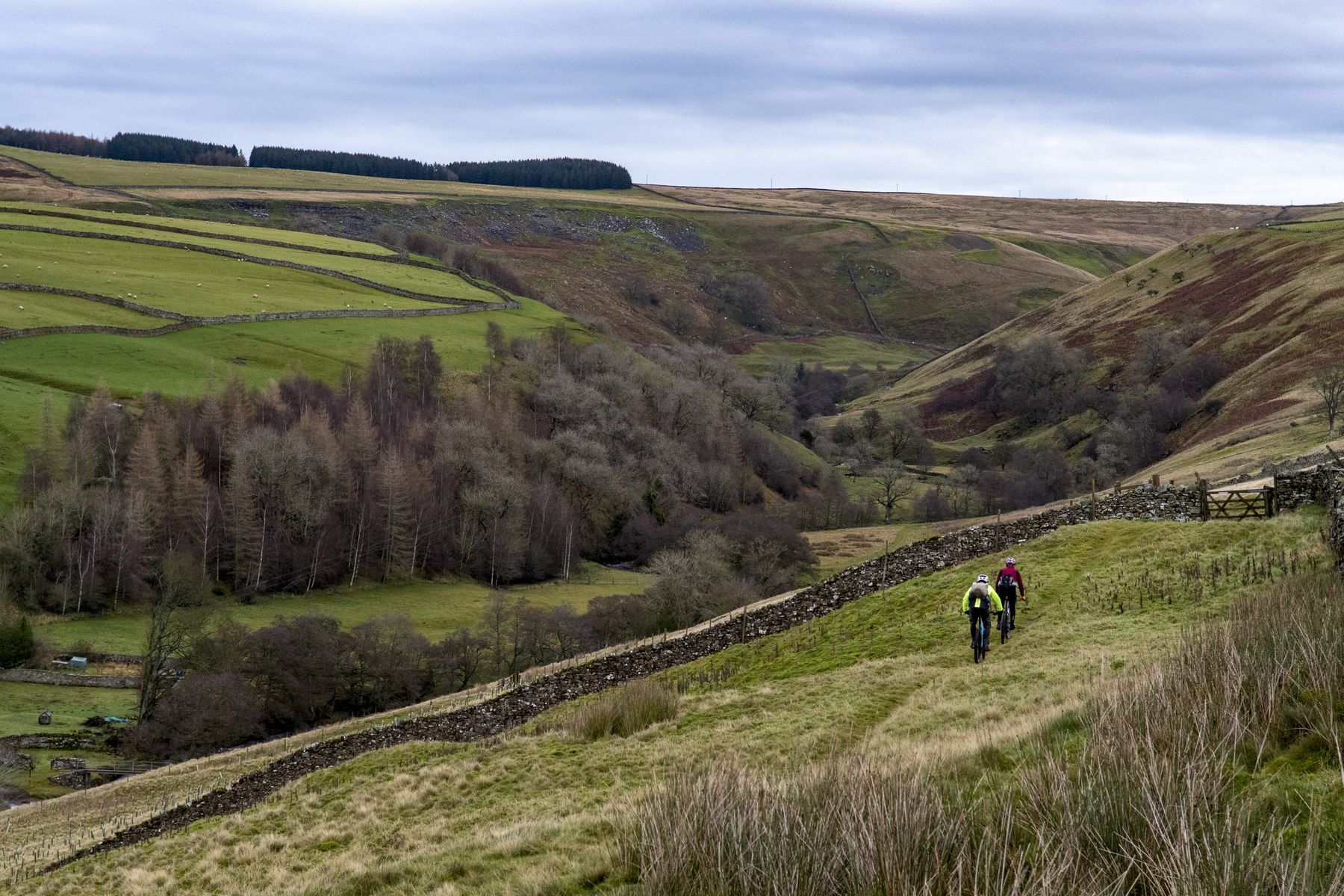
The original idea for this Classic Ride was to try to find something as close as possible to Barnard Castle, for amusingly semi-topical Cummings-related lockdown-breaking reasons. However, from some initial investigations, it became clear that Barnard Castle – while potentially picturesque – is pretty bereft of decent trails.
However, a scant half an hour’s drive south of the benighted town is the village of Reeth. Regrettably lacking opticians, Reeth does boast the Dales Bike Centre – bike shop, accommodation (plague dependent) and, importantly, a coffee and cake shop.
Humblebrag beginnings
Stu Rider, from Riders Cycle Centre in Skipton had kindly agreed to guide me, and he and Calderdale ne’er-do-well Rick Hamilton had agreed to be photo monkeys for the day.
Stu had forewarned Rick and I as to his sartorial preferences, so it was no surprise to find him clad in the finest clingy Lycra that Rapha could offer, which gloriously accentuated legs shaped like a couple of granite-hewn chicken drumsticks. As he bestrode a fully rigid steel Jones like a cycling colossus, I’m sure I could hear glorious choral music burst forth from the clouds. Rick looked nervously at Stu, and then down at his own, more modest and baggily clad pins. He set his face in a look of steely determination and strode towards his Orange Five. I glanced at the (self-described) huge weight of my camera bag, and then I looked at the e-bike I’d brought (Marin Alpine Trail), and, dearest reader, I felt extremely smug.
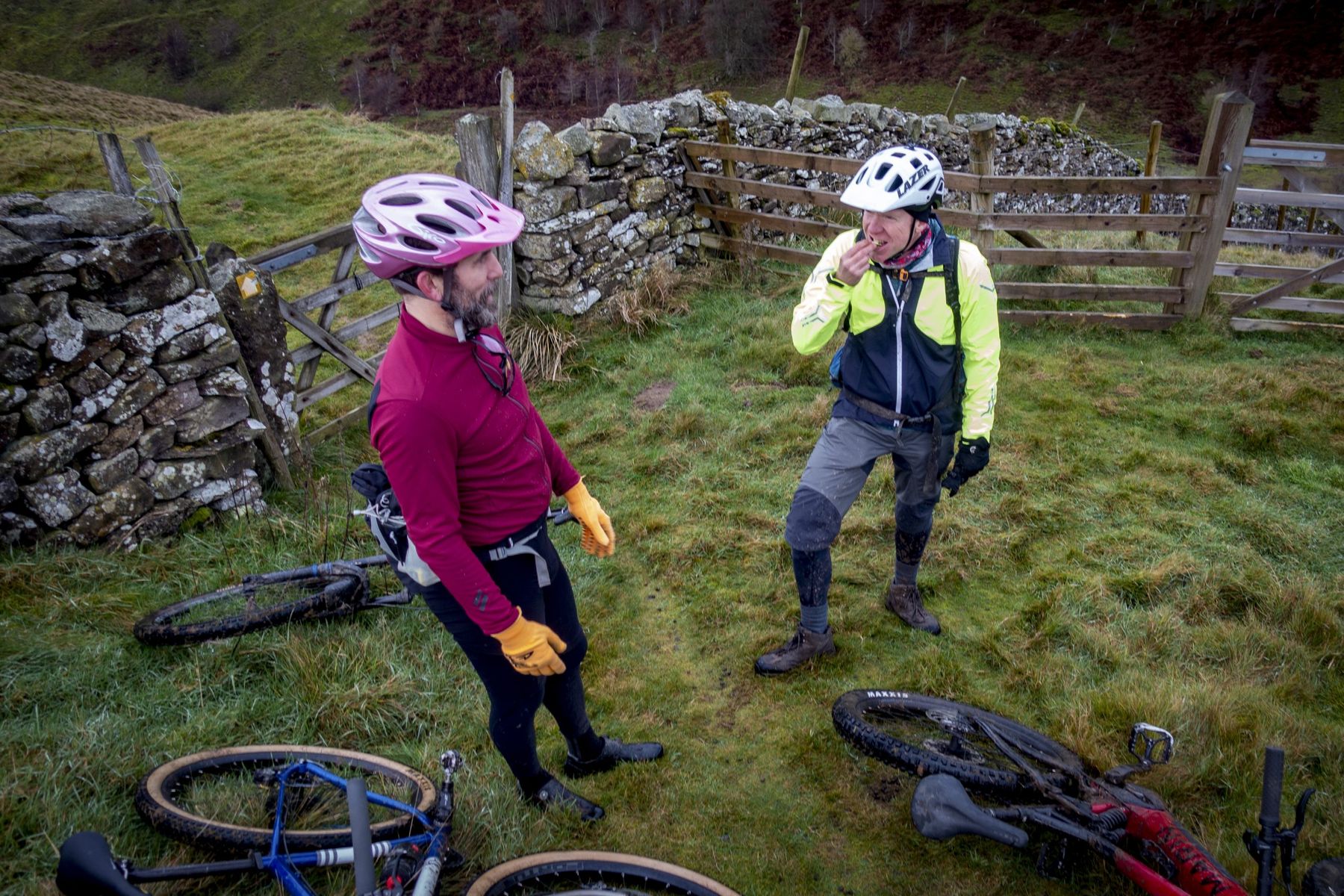
Stuart Price, from the Dales Bike Centre, greeted us warmly. “Have you brought waders?” he chortled gleefully. “It’s a little soggy out there.” My heart sank at the prospect of a drenched camera, and I was somewhat nervous about Stu’s prospective 40-mile route. I wasn’t sure that the battery in the e-bike would last that long, and I really didn’t savour the prospect of riding a 24kg bike up and down the Yorkshire Dales without a motor. Lycra-boy Stu, however, had a manic grin. This was going to be interesting.
Edge of Tomorrow
Fremington Edge was formed at the end of the last ice age. Retreating glacial water caused a huge landslip, exposing all sorts of exciting features and, from our point of view, a whopping great 250m climb. The OS Landranger map of the Edge is sufficiently detailed to provide such helpful features as ‘pile of stones’ and ‘grouse butts’. (How do they preserve them? What do they do with the rest of the grouse?) There is also a worryingly large number of contour lines, which are not even remotely socially isolating. It’s frankly inappropriate in these current times, to have them all clustered together like that. One rule for them; one rule for anyone else.
We swiftly found that, yes, this is the sort of climb that is usually prefaced by the word ‘bastard’. It was horrible, even if you were cheating, like me – or, euphemistically speaking, ‘a great way to warm up’.
Soon, the road expired in a puff of tarmac, stone and water, and we found ourselves grinding up ever-steepening slopes of stones and gravel. It was here, about ten minutes into the ride, that we encountered our first calamity. Even Stu seemed to be evincing some sort of effort – his previously blithe pedal twinkling had been replaced with a decidedly more focused stabs. Motor whirring away, I nervously ventured a look backwards at Rick, and watched the melodramatic death throes of his drivetrain.
THUNK, it went as he drew level. “AARGH,” went Rick. We stopped, but initially couldn’t see anything wrong. Rick remounted, and set off. All was well, until the path kicked up again. The colossal torque put out by Rick’s determined legs was making the chain leap off the chainring, and once it had started, it just didn’t want to stop. Keeping the bike in low gear didn’t help; it was flailing about like a caffeinated four-year-old on a bouncy castle. Rick got off again, and I gave the cranks an experimental waggle. They wobbled. They might even have whimpered. It didn’t look good.
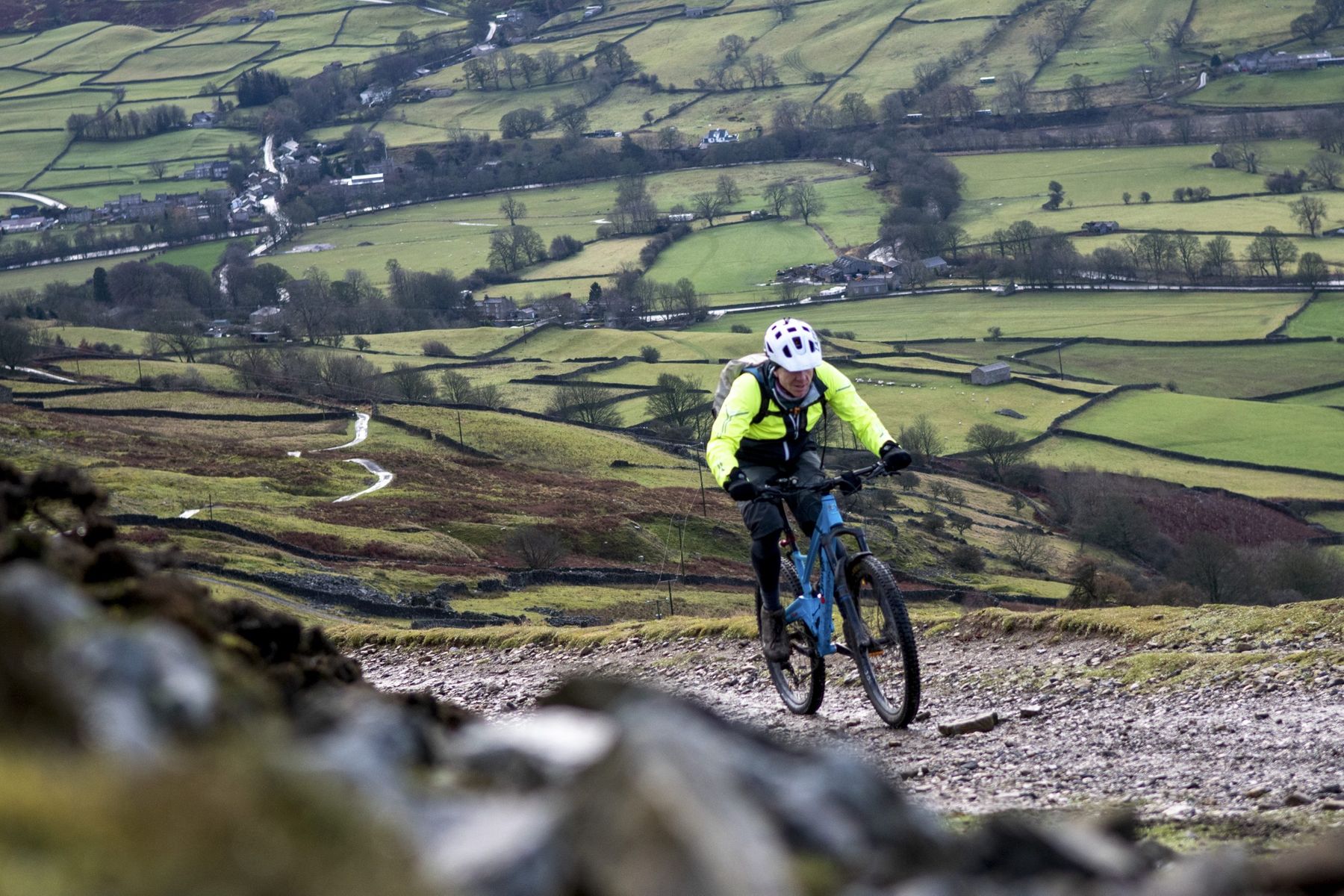
Shakespeare-less insults
Suddenly, to my and Stu’s surprise, Rick ejaculated a litany of surprisingly erudite insults. “A knave! A rascal! An eater of broken meats! Abase, proud, shallow, beggarly, three-suited, hundred-pound, filthy, worsted-stocking knave!” he spat. Stu and I looked at each other, wide-eyed, as Rick started pushing up the hill. “A lily-livered, action-taking knave, a whoreson, glass-gazing, super-serviceable finical rogue; one-trunk-inheriting slave; one that wouldst be a bawd in way of good service, and art nothing but the composition of a knave, beggar, coward, pandar, and the son and heir of a mongrel bitch; one whom I will beat into clamorous whining, if thou deniest least syllable of thy addition,” quoth he.
Stu and I looked at Rick.
“U OK hun?” I called.
“Shakespeare,” he muttered apologetically. “King Lear.”
Blimey. And I thought *I* was verbose. Not sure I’ve ever heard anyone accuse a drivetrain of wearing worsted stockings before.
Luckily, the top of the edge was only ten minutes pushing (or clenched teeth grinding, or – er – straightforward whirring motor spinning) away, and we all more or less crested the hill at the same time. At the top, once Stu and Rick had shoved their now nicely warmed up lungs back in their chests, we considered what to do. It transpired that Rick’s drivetrain only chucked a wobbler under extreme duress; having despatched the worst climb of the day, we elected to push on and hope for the best, but shorten the ride a bit. I breathed a quiet sigh of relief at this point – the chances of me riding a totally flat e-bike home had lessened considerably.
Up on the tops, for a scant few seconds, the sun actually came out. Heather did its level best to flutter prettily, despite its determinedly brown colour, twiggy demeanour, and the stiff December breeze. A fighter plane blasted past bucolically. We failed to notice innumerable disused mine shafts, disused tips, or the butts of grouse. Through half-heard conversation, I gleaned that Stu was suggesting to Rick the best way to cook pheasant. At least, I desperately hoped he was talking about pheasant. “Shove your hand in, clean it out and then ram it full of clementines and oranges”, Stu said with a glint in his eye. Honestly, this wasn’t the way I thought the ride would go.
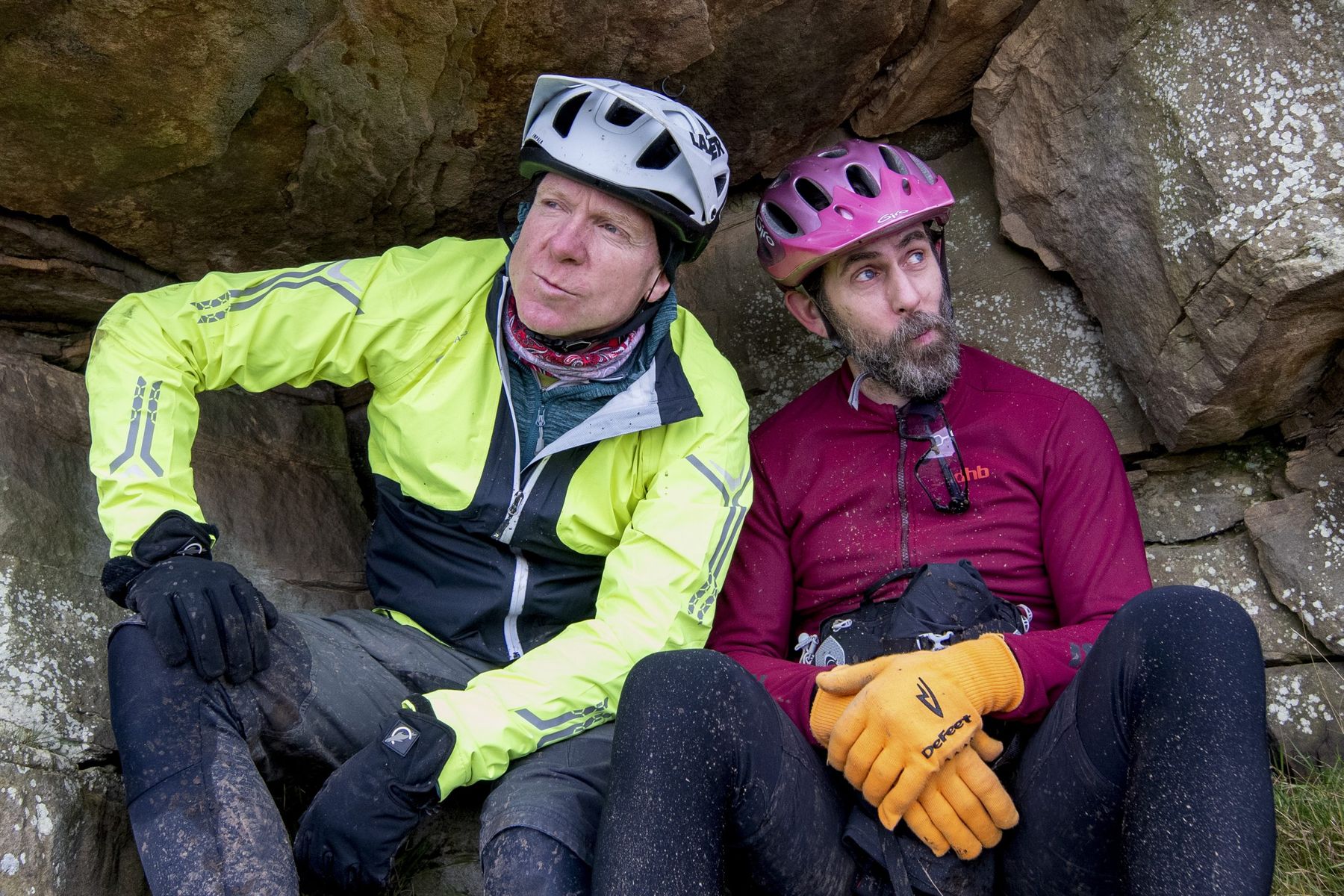
Mud and Butts
A spot of very quiet road work took us to an exceptionally muddy field, past mines (disused), pits (disused) and a farm (emphatically, very, very much used). The sheer quantity of mud surrounding the farm, its depth, viscosity and pure unctuousness, served to obscure the route completely, and as my bike was the heaviest, I was booted into it first. The idea was that I’d set out in a given direction, and if I sank without a trace, Rick and Stu would considerately go in a different direction. I felt really rather loved. My shoes, rather less so.
Unfortunately this meant that, once I’d dragged my sorry carcass through (and the other two delightedly danced over) a veritable cow’s Glastonbury festival latrine-worth of thigh-deep clart, we eventually found the wrong path, and it took a fair amount of professional-grade dithering to get back on the right one again – although once we’d done so, the view was more than worth it. A huge scar cleaved through the landscape; mine ruins dotted here and there. A very pretty faded post-industrial nature-retaking-the-landscape view, even. We ran parallel to this gloriousness for quite a while, down a hilarious descent of Monumental Moistness, to Helwith (nothing to do with the Three Peaks village, by the way). I thought we’d be crossing a ford at the bottom, and perhaps having a cheeky (e-biked me) or well-earned (the others) rest there, but Stu had other ideas.
“Come on!” he called, as he led us up another incline, Lycra-slathered arse pistoning off into the distance. “It’s not far!” he lied.
Stu’s defiantly cross-country hard-ass definition of ‘not far’ and mere mortal definitions were difficult to reconcile. “Are you OK?” I asked Rick, as his eyes started to emerge on stalks. “I’m great!” he replied with forced cheer. “Never better!”
I’m not completely sure I believed him.
Family Values
It’d be easy to peg Stu, given his bold, old-skool sartorial choices, as an ultra-fit cross-country type. And this may well be true, as far as it goes. He races, and wins, and is very, very quick – whereas my trophy shelf is unencumbered by trophies and I suspect my fridge shelf is rather more encumbered with pies. He’s from impressively athletic stock too; his father was an Olympian, and his brother too, as well as spectacularly overachieving in the fields of champion shot-putting and world-champion caber tossing.
But before he eyed up the north and moved to Skipton, Stu used to race and ride with skills coach Tony Doyle, and spent ten years helping to build and maintain the Herts North Shore (Google it, and prepare to be terrified) – so he clearly knows more than a thing or two about some of the more technical aspects of riding.
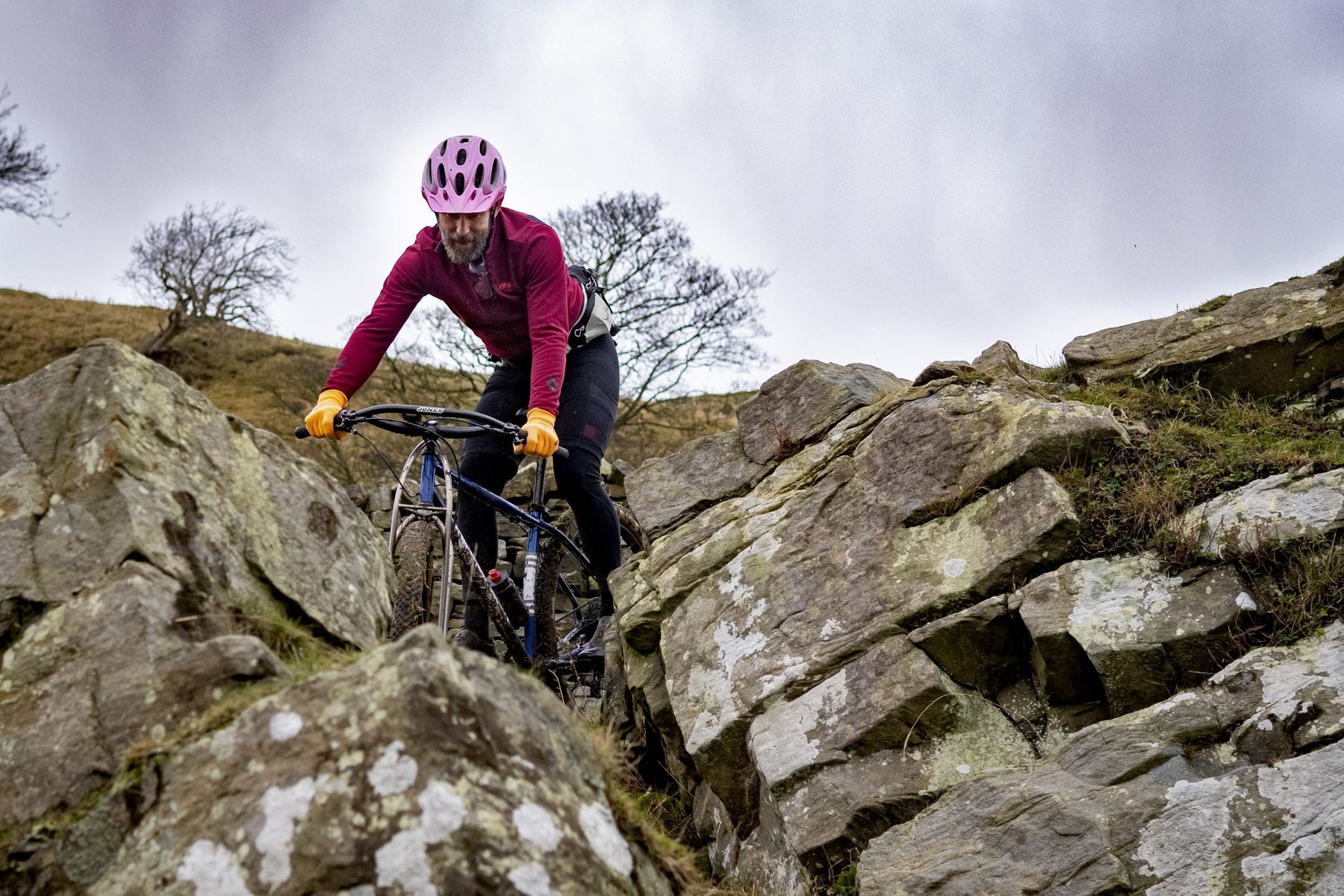
Thus far, true, we hadn’t seen much evidence of any technicality – our riding for the most part was on open paths, or snaky singletrack without too many gnarly features – which gave us ample time to enjoy the glorious scenery. And in the somewhat inclement December weather, though, this was all to the good. We gained height quickly, enjoying the tranquillity of this corner of the Dales unencumbered by having to pucker our arses down anything nadgery, but I was feeling pangs of an arse-puckering nature. I made some polite enquiries to Stu – but he simply tapped his nose enigmatically, and smiled a secret, coquettish smile. Intriguing.
Pulling out of Marske, we headed into a small wood. Muddy, wet, oppressive. The ominous silence was only punctuated by the occasional TAT of shotguns aiming at grouse (butts?) a little way below us. Rick espied an enormous hollow tree, and hurtled towards it. Casting his bike aside, he squirmed his way inside the tree, and refused to come out until we’d fed him peanut butter squares.
Over Hill and Dale
Once we’d managed to place a now replete Rick back on his bike, more fearsome hills needed to be conquered before the alluring tech demons could be assuaged. As one might imagine, time was pressing, so we set off at pace. Stu was at the front; lithe form scything through the Yorkshire air like a Lycra-slathered butterknife through a warm Yorkshire Parkin. Rick was further back, forcing his way up the hill with nothing but pure determination and peanut butter squares. I kept asking him if he was OK – I suspect this was beginning to grate, as each protestation in the affirmative was issued through more and more tightly gritted teeth. I was beginning to suspect that eloquently Shakespearean insults might be soon aimed at me and my quietly whirring motor. I decided to scarper.
Back on the tops, as we crossed Hurst Moor, we had a little more time to appreciate the terrain. There are a lot of disused lead mines around here. At one point, 10% of the country’s lead was made in the area, and came through Reeth. It’s fair to say that the entire landscape has been altered by the stuff. Enormous tips pepper the place, and made for entertaining diversions – Stu in particular was leaping his bike off them with gleeful abandon.
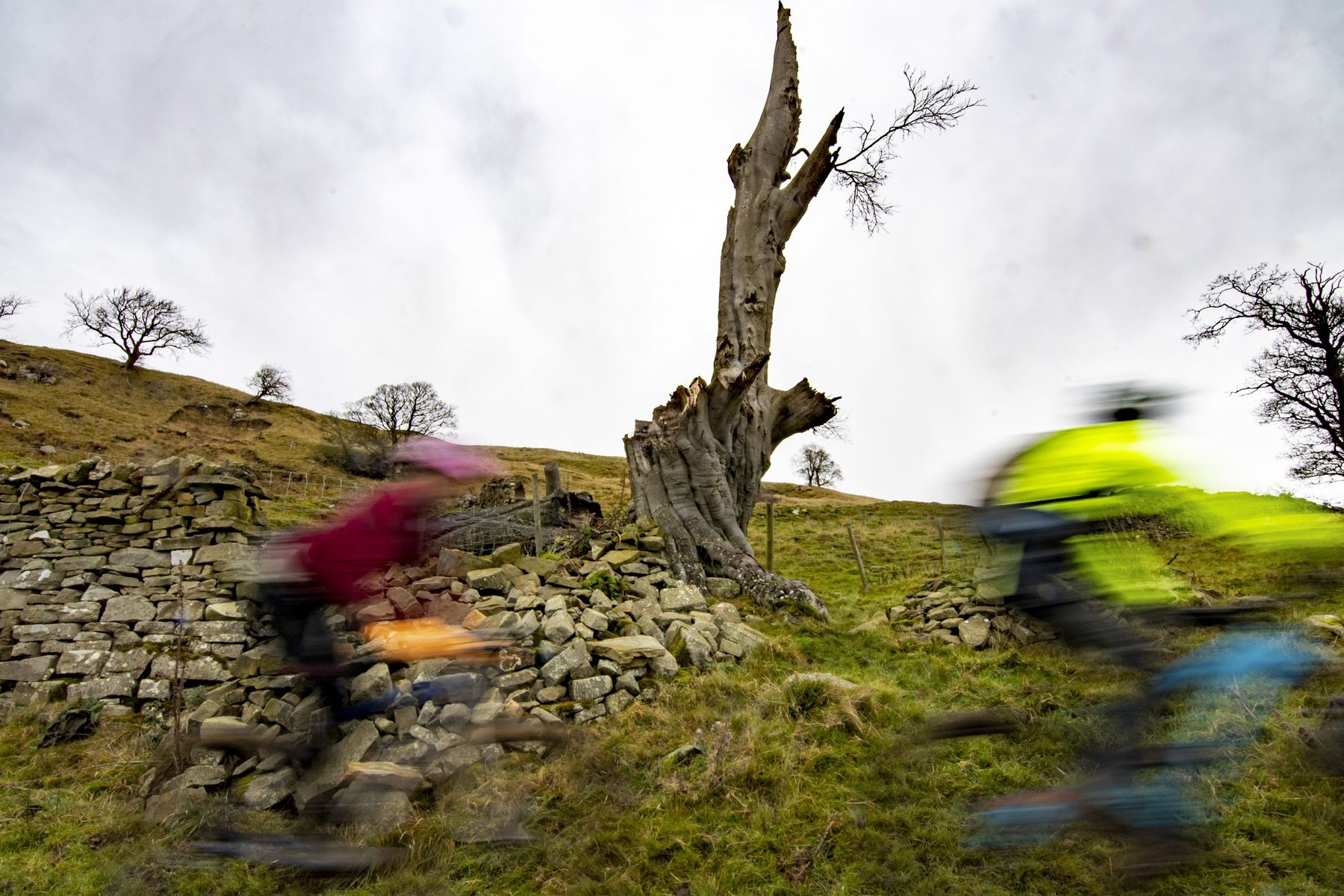
Over the tops, the terrain becomes even more barren. Vestigial snow lay sulking in depressions in the ground, surrounding little trickles of meltwater or tiny streams. A strange sort of beauty – there was no overriding impression of industry, nor of nature, more a melding of the two. I honestly couldn’t tell what was vestigial workings and what wasn’t.
The trail here narrowed, and began to head downwards. Gently, at first, and then with more plummet-y enthusiasm. And swiftly we are upon the final descent. It’s a glorious thing. Old mine works, of course, but the trail snakes around and through them – a sinuous and lithe braid, interspersed with rock. It’s not hard if you go slowly; it’s substantially harder if you take it with pep, and there are alternative routes to further spice up the technicality, if you so choose. It would be something of a cliché to say it was a total hoot – but I’ve never been one to care overmuch about such things, because it was. The only downside, perhaps, is that the trail narrowly misses going through a hamlet called Booze. And I desperately wanted to ride through Booze. It’s one of my lifelong ambitions, like a swimming pool full of rice pudding.
By now, darkness was falling, and our eyesight was (ironically) failing – so all that was left to do was hightail it back to the van. My bike’s battery had stuck itself into ‘whimper’ mode, and would need a fulsome charge; Rick had been thrusting his nose firmly into the pain cave for some time although he manfully denied it, and Stu appeared as fresh as a daisy. A mud-covered daisy, admittedly, but still… We pulled back into the Bike Centre just as it was getting dark – the coffee and cake we inhaled here were very much deserved. A thoroughly fine day out.
Why bother?
This part of the world, sitting as it does on the very northern edge of the Yorkshire Dales national park, has all the attributes of the area. Huge rolling landscapes, old mine workings, vast views, glorious desolation, nooks and crannies.
The geography around here is typically limestone – which means it can get skittish in the wet, but most of the trails are pretty good going. And it’s fair to say that, yes, there are ample opportunities to get wet (this is Yorkshire after all). The Dales and environs have always been lauded as excellent mountain biking landscapes, although perhaps lacking some of the prestige of the Peak District or the Lakes – not least because of ease of access. It’s not hard to get to, per se, it’s just that there’s a spot of dual carriageway and A and B-road required after you leave the motorway. But, of course, the upside of this is that the place is much quieter than those other areas, and so you’ll meet vastly fewer people on your travels. We saw practically no other riders or walkers when we went – granted, it was December in perhaps the strangest year in living memory, but still – the sense of glorious isolation is hard to get, sometimes, in busier places. In the Peaks, for example, you could reach the top of a climb, and you be exulting in your monumental achievement when you’re interrupted by a large troupe of sturdy outdoors-folk, all congratulating themselves on the same thing and wondering what’s for lunch. It doesn’t happen nearly as often in the Dales. This is all to the good, but, of course, it does mean that making sure you’re adequately prepared is a very good idea. Peace, quiet and solitude comes with a hefty price if you crash.

There’s a lot of doubletrack in the area, which means that there’s generally good riding available in most weathers, at the expense of nadgery tech. But this is also there to be found, if you look for it. Our Classic Ride here keeps vistas and firm-going to the forefront for the most part – not least because it was ridden in December, although we still managed to find some spice to season all that scenery. If we’d had the weather, the mechanical fortune and the daylight, we’d have struck north over the moors to The Stang and Barningham, which would make a great addition to this ride – it’ll easily add a couple of hours on too, mind you. Whether you head north, as this ride does, and into the northern Pennines, or you head south and west from Reeth into the Dales National Park, there are innumerable opportunities for riding – and there’s usually a glorious view or a nugget of intriguing local history around every corner.
- Distance: 31km
- Max Elevation: 461m
- Total Ascent: 940m
- Time: 3–5 hours
- Maps: Explorer OL30
Stuart and Brenda Price run the Dales Cycle Centre, which has a variety of bunk rooms and B&B accommodation – dalesbikecentre.co.uk 01748 884908
There’s plenty of other accommodation available too – try the Black Bull
• theblackbullreeth.co.uk
• riderscyclecentre.com
Perhaps as expected, travelling options are limited. You’re restricted to the car, really – the nearest railway station is Darlington or Kirkby Stephen – they’re both just over 20 miles away. There’s plenty of parking in the villages though, and there’s parking available at the Dales Bike Centre, too.
The Dales Bike Centre, naturally, has a well-stocked shop, with bike hire and a bike wash also available. There’s also Arthur Caygill Cycles in Richmond – 01748 825469
Once again, the Dales Bike Centre comes to the rescue, with an excellent cafe and cakery (more savoury foodstuffs also available). The coffee is excellent, too. The Black Bull is popular with good reviews for evening meals, although we didn’t get to sample its wares. On the tops themselves, though, there are precious few facilities, so taking stuff with you is strongly advised, even if it’s just get-you-home jelly babies.
Huge thanks to Stu from Riders Cycle Centre repair workshop in Skipton for agreeing to guide us.
This feature was produced with support from Komoot.
For more details of this route and others, head to singletrackworld.com/komoot to follow us.





